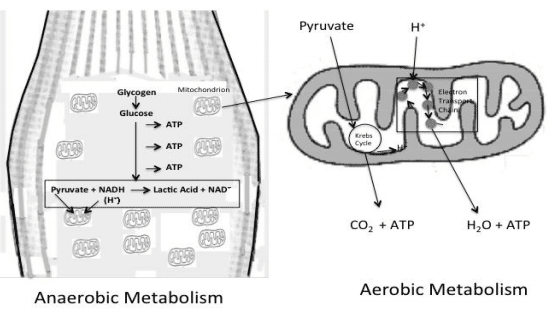It was a common belief and perception that one of the reasons of muscle fatigue was the amassing of Lactic acid in the body. During the exercise, the body of an individual produces the harmful substance, called Lactic acid, and is one of the primary reasons why the muscles and by extension of it, the entire body feels pain and soreness. But it false perception has been debunked by the recently carried out researches. It is, on the contrary, the lactic acid is not a harmful byproduct of an intensive exercise, but instead, the adverse effects of the lactic acid are minimal.
The concept that many people were harbouring for a long time that the lactic acid is produced when an athlete does an exercise is a false belief. As a matter of fact, the lactic acid is not necessarily produced by the muscle, but rather a compound, which is to some extent akin to lactic acid, ‘Lactate’ is produced. Lactate is not a waste or a byproduct, as it was once thought it was. Lactate is the linkage between the two types of metabolism i.e. anaerobic and aerobic. The fundamental difference between the two metabolisms is that the anaerobic metabolism does not require the need for oxygen, but aerobic metabolism cannot take place without the presence of oxygen. The fatigue in the muscles because of lactate or in simple terms, lactic acid, is only caused when the intensive exercise is done by a person and that lactate is unable to be transferred to the mitochondria, to save the body from any fatigue. Mitochondria is the part where the metabolism takes place in the presence of oxygen, which is aerobic metabolism. It is in Mitochondria where the breakdown of glucose and other fats take place, which is used for energy. The failure of the body to transport the hydrogen ions and pyruvate safely into mitochondria is due to the fact that there is not enough oxygen to bring about the process. The hydrogen ions and pyruvate combine to form lactic acid.
There is also a false perception that the lactic acid is the waste product anaerobic glycolysis, in which glucose is transferred to lactate, even when oxygen is in small quantity present in the body. It helps to provide energy for a very limited period of time, mostly lasting for two or two and a half minutes. But the research done in 2008, made us aware of the fact that the removal of lactic acid is very much possible from the muscles. The conversion of lactic acid, back to glucose is possible and the storage place for glucose is the liver, which can be utilized for the future use (Wilmore, Costill, & Kenney, 2008).
A.V. Hill, a Nobel award winner, in the year of 1924, presented his idea of the contraction and fatigue of muscles due to lactic acid. He proposed that it was because of the lack of oxygen during the intensive exercise that the body was not able to remove the lactic acid and it got accumulated in the muscles and that is the main reason for muscle contraction and fatigue, which is felt by an individual after exercising (Hill, Long, & Lupton, 1924). This model was mostly used by the early researchers and they based their theories and researchers on this concept. But in the year of 1995, it was stated in a report that, lactic acid was not found interfering with the contraction and fatigue of muscles (Pate et al., 1995). The examination of lactic acid forced many of the researchers to carefully inspect and revise the factor of lactic acid in muscle contraction.
Some of the other common misconceptions about the lactic acid are that people believed that it plays no role in the contribution of the performance of the exercise. As discussed earlier that Mitochondria helps in the breakdown of glucose and gives energy during exercise and improve the performance of an athlete. People also believe that most athletes produce less lactic acid and that is why they are better than others, but that is not the case. The low production of lactic acid in their bodies is due to the fact that they utilize much more than ordinary people that is why their exercise time is more than the normal people. There were many misconceptions about lactic acid being dangerous for the body, but recent researchers prove otherwise.
References
Hill, A. V., Long, C. N. H., & Lupton, H. (1924). Muscular exercise, lactic acid, and the supply and utilisation of oxygen. Proceedings of the Royal Society of London. Series B, Containing Papers of a Biological Character, 97(681), 84–138.
Pate, R. R., Pratt, M., Blair, S. N., Haskell, W. L., Macera, C. A., Bouchard, C., … King, A. C. (1995). Physical activity and public health: a recommendation from the Centers for Disease Control and Prevention and the American College of Sports Medicine. Jama, 273(5), 402–407.
Wilmore, J. H., Costill, D. L., & Kenney, W. L. (2008). Aging in sport and exercise. Physiology of Sport and Exercise. 4th Ed. Champaign: Human Kinetics, 402–421.







